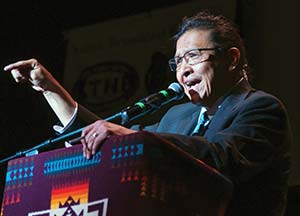Cal Nez brings business experience to his effort to become tribal president
By Lane Franklin
Navajo Times
WINDOW ROCK, June 19, 2014

(Times photo – Ravonelle Yazzie)
Presidential candidate Cal Nez speaks during the Shiprock Navajo Nation Presidential Forum on June 5.
He hopes the next hat he puts on will be as the president of the Navajo Nation, a role that will allow him to utilize the tribe’s greatest resource: the Navajo people.
“My family is the entire nation,” he proclaims.
His wife Yolanda and their five kids make up his immediate family. His two daughters are married with children, his oldest son is currently overseas serving a mission in France and the two youngest boys live with Nez and his wife in Sandy, Utah.
As a successful businessman, Nez wants to apply his extensive knowledge of entrepreneurship for the betterment of economic development on the Navajo Nation.
In a 2011 article by the Navajo Times, Nez was featured alongside Asa Begaye, Jennifer Gillson, Pete Nez Jr. and Jessica Stago as the founding members of the Navajo Chamber of Commerce. This group had officially forged the Navajo Nation’s first chamber of commerce with a launch on June 24, 2011, the day Navajo Nation President Ben Shelly and Vice-President Lee-Jim declared Navajo Chamber of Commerce Day.
In the same article, Nez radiated pride in that momentous day with comments concerning economic independence and sustainability for the Navajo people.
“We can do it, we have it in our spirit and heart. We were self-sufficient, and self-reliant before 1492,” he said.
His contributions to the establishment of the commerce exemplify the in-depth relationship he has had with the Navajo Nation for the past 27 years.
In addition to the Navajo Chamber of Commerce, Nez also hosts a weekly internet radio show called Politics on the Navajo Nation, a show addressing political and social issues as a means of empowerment for all.
These distinct ventures propelled him forward into the running for Navajo Nation president from his experience with previous administrations. The experience he has gained fostered a strong belief that the reality of the Navajo Reservation is misconstrued with people being taught to look to the government for entitlement.
“T’aa hwó ajít’éego!” Nez explains, “It’s your own ability to survive.” Referring that the business concept of being self-reliant and self-sufficient can be applied to the tribal government and the people.
This sustainability allows for the benefits of business to enable its beneficiaries to be able to provide for themselves and their families the bare essentials of life such as shelter, food, and clothing.
“It’s not all about making money,” as he goes into further explanation of his platform.
His focus is economic development, which means jobs, jobs means self-reliance, self-reliance means empowerment; empowerment means a strong Navajo Nation.
“The Navajo Nation is not lacking money,” Nez confidently reveals concerning the millions of dollars that he says are not effectively utilized.
That robust amount of money can be used to develop certain industries, he adds. Empowerment of the chapters for a more localized approach will allow for the central government to play the role of a silent public servant.
Through the revitalization of t’aa hwó ajít’éego, every Navajo person can become a contributing member of society by self-improvement and family engagement, to give rather than to take, Nez elaborated.
The life he lived before his run for the presidency greatly impacted the direction he would like to see the tribe head in. He is Táchii’nii (Red-Running-Into-Water People Clan) and born for Tl’ááschí’í (Red Bottom People Clan).
Nez was born during the dusty Shiprock Fair on Oct. 4, 1958 and thus began a life heavily influenced from an upbringing with his grandparents, Bitonie and Mary B. Nez. While his mother was in labor at the Shiprock hospital, his grandparents made the trip to the old hospital across the bridge by hitchhiking from their hogan in Tsé Alnáoz’t’i’í.
Nez’s mother and father were not actively present in his life but he turned a negative into a positive; their absence forged the foundation of who he is today. His grandparents spoke no English, his home was a hogan, and his family’s mode of transportation was a horse-drawn wagon.
“Believe me, I know the traditional way of life,” Nez stated, adding that he was raised in the manner of his grandparents’ generation.
At the age of six, like many Navajos of his generation, he was forced to live at BIA Sanostee Boarding School. His native tongue was forbidden and his Navajo way of life was replaced with the American style. Nez continued his education at Newcomb Junior High and in Salt Lake City, where he attended South High School.
He recalls the words his grandparents spoke to him before he left for Utah, “You are on your way. We are willingly sharing you with the world."
Nez’s departure to Utah, cemented his mentality of “Never forget who you are as a Navajo.” His scholastic journey advanced into college as a Sterling Scholar of the visual arts at Utah State University.
This exposure to such beneficial education led Nez to excel in the graphic design world under the tutelage of Ted Nagata, a renowned graphic artist. Nez would continue to excel with his establishment of his own business, Cal Nez Design in 1983.
Nez and his design firm have also been the recipients of local, metropolitan, national and international awards. His accolades are evident of his inspiring potential to shine at any endeavor he pursues.
“The Navajo Nation deserves the same type of opportunity if they want a top-notch design,” he added to his assurance the tribe can benefit from his talent.
How to get The Times:

